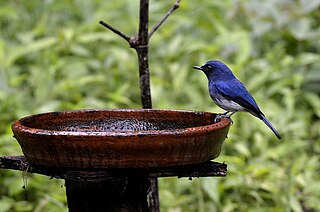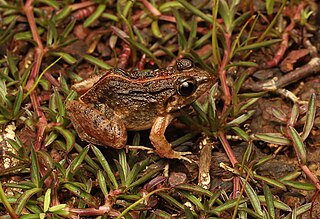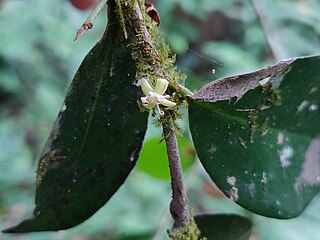
The Western Ghats, also known as the Sahyadri mountain range, is a mountain range that covers an area of 160,000 km2 (62,000 sq mi) in a stretch of 1,600 km (990 mi) parallel to the western coast of the Indian peninsula, traversing the states of Gujarat, Maharashtra, Goa, Karnataka, Kerala and Tamil Nadu. It is a UNESCO World Heritage Site and one of the 36 biodiversity hotspots in the world. It is sometimes called the Great Escarpment of India. It contains a very large proportion of the country's flora and fauna, many of which are endemic to this region. The Western Ghats are older than the Himalayas. They influence Indian monsoon weather patterns by intercepting the rain-laden monsoon winds that sweep in from the south-west during late summer. The range runs north to south along the western edge of the Deccan Plateau and separates the plateau from a narrow coastal plain called the Western Coastal Plains along the Arabian Sea. A total of 39 areas in the Western Ghats, including national parks, wildlife sanctuaries and reserve forests, were designated as world heritage sites in 2012 – twenty of them in Kerala, ten in Karnataka, six in Tamil Nadu and four in Maharashtra.

The white-bellied blue flycatcher is a small passerine bird in the flycatcher family Muscicapidae. It is endemic to the Western Ghats of southwest India. Males are dark blue with a lighter shade of blue on the brow and have a greyish white belly. Females have a rufous breast, a white face and olive grey above.

Troides minos, the southern birdwing, also called Sahyadri birdwing, is a large and striking swallowtail butterfly endemic to South India. With a wingspan of 140–190 mm, it is the second largest butterfly of India. It is listed as Least Concern in the IUCN Red List.

Pachliopta pandiyana, the Malabar rose, is a swallowtail butterfly belonging to the genus Pachliopta, the roses or red-bodied swallowtails.

The genus of the myrrhs, Commiphora, is the most species-rich genus of flowering plants in the frankincense and myrrh family, Burseraceae. The genus contains approximately 190 species of shrubs and trees, which are distributed throughout the (sub-) tropical regions of Africa, the western Indian Ocean islands, the Arabian Peninsula, India, and South America. The genus is drought-tolerant and common throughout the xerophytic scrub, seasonally dry tropical forests, and woodlands of these regions.

Stenocereus thurberi, the organ pipe cactus, is a species of cactus native to Mexico and the United States. The species is found in rocky desert. Two subspecies are recognized based on their distribution and height. The Organ Pipe Cactus National Monument is named for the species.

Minervarya syhadrensis, commonly known as long-legged cricket frog, Syhadra frog, Bombay wart frog, and many others, is a species of frog in the family Dicroglossidae found in India, Bangladesh, and Nepal at low to moderate elevations. It is the type species of genus Minervarya. In view of its wide distribution and stable population trend, IUCN assessors listed it as Least Concern in 2009 and 2016.
The Bombay swamp eel, also known as the paytop in Marathi, is a species of fish in the family Synbranchidae. It is endemic to the state of Maharashtra in India.
Acanthopale is a plant genus of shrubs or subshrubs in the Acanthaceae plant family. The genus name is based on the classic Greek words for thorn ákantha and stake palum. Some species in the genus are cultivated as ornamental plants.

Brillantaisia is a genus of plants in the family Acanthaceae. They are native to the African tropics and subtropics, including Madagascar. They may grow from 20 cm to 2 m in height. Their hirsute stems are square in cross-section and their heart-shaped leaves have an opposite arrangement. Their purple or white pea-like flowers produce long, cigar-shaped seed pods. They reproduce easily from seeds or vegetatively. One species, B. lamium, is invasive in Queensland.

Syzygium densiflorum is a species of evergreen tree in the family Myrtaceae. It is endemic to the Western Ghats mountains, India. The species is categorised as Vulnerable in the IUCN Red List.

Vateria indica, the white dammar, is a species of tree in the family Dipterocarpaceae. It is endemic to the Western Ghats mountains in India. It is threatened by habitat loss. It is a large canopy or emergent tree frequent in tropical wet evergreen forests of the low and mid-elevations.
Karian Shola National Park is a protected area in the Western Ghats, India, nominated as a national park in 1989. The Western Ghats are a chain of mountains running down the west of India parallel with the coast some 30 to 50 km inland. They are not true mountains, but the edge of a fault that resulted about 150 million years ago as the subcontinent of India split from Gondwanaland. They are older than the Himalayan mountain range and are clothed in ancient forests. They influence the weather in India as they intercept the incoming monsoon storm systems. The greatest rainfall occurs between June and September during the southwest monsoon, with lesser amounts falling in the northeast monsoon between October and November. The Western Ghats are a UNESCO World Heritage Site and are considered to be one of the eight most important "hotspots" of biological diversity in the world.

Tropical evergreen forests of India are found in the Andaman and Nicobar Islands, the Western Ghats, which fringe the Arabian Sea, the coastline of peninsular India, and the greater Assam region in the north-east. Small remnants of evergreen forest are found in Odisha state. Semi-evergreen forest is more extensive than the evergreen formation partly because evergreen forests tend to degrade to semi-evergreen with human interference. There are substantial differences between the three major evergreen forest regions.The average annual rainfall is 65-75 inches.

Boucerosia frerei is a plant in the genus Boucerosia which contains several species many of which are native to the Indian subcontinent and one species, Boucerosia crenulata, native to Myanmar. B. frerei, is a small succulent endemic to the forest area in the Western Ghats and Deccan plateau in Maharashtra state in India. It is also grown as a greenhouse plant by succulent plant enthusiasts. At one time, it was on the IUCN list of twelve most endangered species on earth, but conservation efforts have brought it back from the brink of extinction.

Leea indica is a large shrub in the family Vitaceae which may grow up to 5 m (16 ft) tall. It is common in undergrowth of secondary and disturbed evergreen forests in Indomalaya, Indochina, and throughout in the Western Ghats of India. Plants growing in Malesia, New Guinea, Australia and southwestern Pacific islands were previously identified as this species but are now considered to be the separate species Leea nova-guineensis.
Isachne meeboldii is a critically endangered species of herb endemic to open grasslands in Western Ghats of India. It has been reported from Shimoga and Kumsi in the state of Karnataka and Aurangabad in Maharashtra.

Nasikabatrachus bhupathi, or Bhupathy's purple frog, is a frog species belonging to the family Nasikabatrachidae. It can be found in the Western Ghats in India and was discovered near the Srivilliputhur Grizzled Giant Squirrel Wildlife Sanctuary. The specific epithet honors the late Indian herpetologist Subramanian Bhupathy (1963–2014).
Cephalophis lukei is a species of flowering plant belonging to the family Acanthaceae. It is a perennial or subshrub native to southeastern Kenya and Mozambique. It is the sole species in genus Cephalophis.

Drypetes wightii is an evergreen tree species endemic to the Western Ghats, India. The species is considered Vulnerable under the IUCN Redlist of Threatened Species.
















